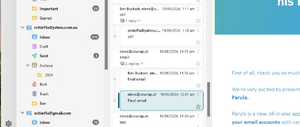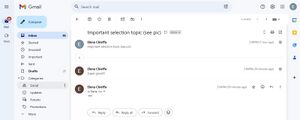ReviewThreading
We have grouped some of the most used systems to understand their advantages and disadvantages and spark ideas on possible solutions to old problems.
According to my understanding, there have been good advancements in UI design for email threading in the last years, particularly the fact of displaying newer emails at the top of threads. This approach now aligns more intuitively with users' natural reading patterns and chronological expectations.
Here a quick threading overview of some of the most used software
Thunderbird (version 128.6.0esr)[edit | edit source]

The visual selection is clear, and there's a nice timeline graph on the left. I expected to find indentation for second-level threading, but it remains at one level.
About the threading behavior:
- Thunderbird displays threads with the original message at the top level, and subsequent emails within the thread are rendered from oldest to newest.
- The threading view can be toggled on or off for individual folders.
- Thunderbird does not currently offer an option to sort conversations in reverse order within a thread
The subject seems to appear on all messages under the same thread. I'm asking myself whether it is necessary or if it clutters the space without much point.
Gmail (Web app)[edit | edit source]

Gmail's threading stacks conversation messages with the newest unread message on top and the last two emails of a thread, prioritizing usability over precise message hierarchy and intentionally allowing users to expand the rest of the messages.
Gmail groups emails if each message meets the following criteria:
- The same recipients, senders, or subjects as previous emails.
- A reference header with the identical IDs as an earlier message.
- Sent within one week of an earlier message.
Gmail will break an email thread if the subject line changes or the email chain grows beyond 100 emails.
Asking myself, is there enough context for the user? Context from intermediate messages can be lost, potentially leading to misunderstandings or incomplete information. The condensed view might not provide enough information for users to decide whether to open a thread or not.
Also the system could automatically groups messages that are nor supposed to be grouped.
Outlook[edit | edit source]
Outlook groups emails with the same subject line into conversations, but changes in subject lines can create new threads or split existing ones. Users report issues with conversations being grouped randomly or incorrectly, especially when dealing with similar subject lines but different recipients. Threading large numbers of emails can be resource-intensive, affecting Outlook's responsiveness.
One person during my surveys mention his difficulty in determining where messages in a thread start and end, because of the plain UI and just a thin devider.
Apple Mail[edit | edit source]
By default, Apple Mail will group emails from the same thread. There is a feature that highlights time-sensitive emails at the top of the inbox, integrating with the threading system. Apple Intelligence provides short summaries of emails and entire threads directly in the inbox, helping users quickly grasp the content. The threading can sometimes show only the latest message in the thread, possible to change settings.
Missive[edit | edit source]
Threading is considered a core feature and cannot be turned off, unlike some email clients, Missive keeps threading enabled at all times. Individual emails can be moved out of a thread into a new conversation if needed. Before December 2024, Missive was threading incoming replies with different subjects, no longer the case.
Super Humans[edit | edit source]
Super Humans can naturally identify when a conversation within a thread shifts to a new topic, even if the subject line remains unchanged. In Super Human there is Auto-Summarize, a Superhuman AI feature which summarizes the entire email chain, giving you the key information without having to dig through each email. Team members can have private discussions within email threads without risk of accidentally sharing with external recipients.
Spark[edit | edit source]
Spark seems to have an interesting threading system, which goes beyond simple chronological ordering. It uses advanced algorithms to group related emails together, even if they have different subject lines or involve multiple participants. It allows users to mute entire threads, and snoozing them temporarily removing them from the inbox and having them reappear at a specified time.
For long email threads, Spark provides a summary view from December 2023, allowing users to quickly catch up on the key points of the conversation without reading through every message. This Ai Summary feature, generates a brief 1-2 paragraph overview of the email thread or action points highlighting the necessary actions within the email.
P.S. I could add only the pictures of the software I am using due to copyrights. Feel free to ask Google.
Commun issues with email threading[edit | edit source]
According to user reviews in the internet we can say that some of the most commun issues about their threading system are:
Email threads can get too long[edit | edit source]
Message threads can become too long and essential information often gets buried.
As threads grow longer, it becomes increasingly difficult to:
- Find specific information or decisions
- Identify new responses or updates
- Keep track of the overall conversation - scrolling through long threads becomes cumbersome
- Attachments can sometimes cause problems within threads - becoming hard to locate or disappearing
More[edit | edit source]
- Redundant or irrelevant responses due to not reviewing the entire thread
- Difficulty in following conversations when subject lines or participants change
- Risk of sending sensitive information to unintended recipients
- Side topics cluttering the main conversation
Feel free to add more issues you are encoutering with mail threading!